The iPhone 7 and iPhone 7 Plus Review: Iterating on a Flagship
by Joshua Ho & Brandon Chester on October 10, 2016 8:00 AM EST- Posted in
- Smartphones
- Apple
- Mobile
- iOS
- iOS 10
- iPhone 7
- iPhone 7 Plus
System Performance
Section by Brandon Chester
At the heart of a smartphone lies the SoC. While there's now an increasingly common belief that specifications don't matter, the truth of the matter is that almost all of the software features that users now take for granted in a smartphone have only been made possible by the continued improvements in hardware performance. Modern smartphones with high resolution displays and complex interfaces would not exist if the available CPU and GPU processing power hadn't advanced as much as it has. On top of that, performance is something of a gating factor for software development, as the innovation that happens in software has to happen within the boundaries of what can be done with the hardware. Specifications in a smartphone actually matter quite a lot, even if the user isn't actively aware of all the individual components that make up their smartphone's SoC.
With the iPhone 7 Apple doesn't have the benefit of a new major process node to help improve performance. Any improvements will be the result of architectural improvements, as well as improvements that have been made to TSMC's 16nm process since the release of the Apple A9, which was Apple's first FinFET SoC. It's important to note that one of the goals of A10 Fusion is improving dynamic range, so the focus isn't solely on improving performance. However, device performance seemingly must improve with each generation, and Apple is advertising a 40% improvement in CPU performance and a 50% improvement in GPU performance with A10 Fusion compared to A9.
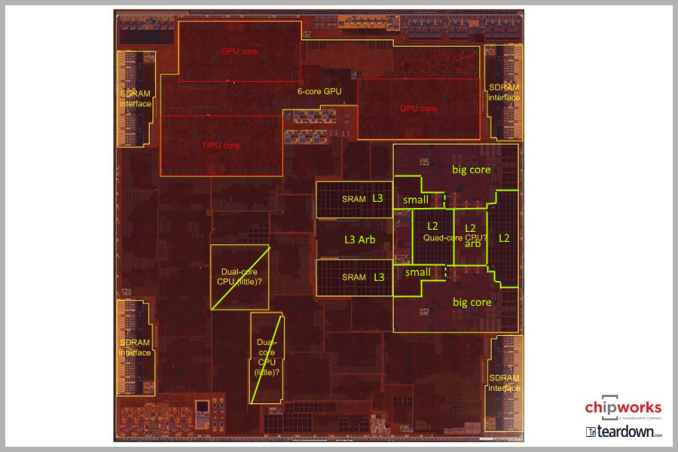
A10 Fusion's Floorplan (Special thanks to Chipworks)
While an in-depth look at A10 Fusion will have to wait until our seperate technology deep dive, we can still take a look at how performance has changed at a higher level. A10 Fusion's peak frequency is 2.3GHz, up from 1.8GHz on A9. This gives a theoretical improvement of 28% on its own, and the remainder will have to come from improvements to the architecture in Apple's (big) Hurricane cores. Based on our testing so far, Hurricane is not radically different from Twister (A9), but Apple has been making some optimizations. Meanwhile it should be noted that while A10 technically has four CPU cores – the two Hurricane cores and the two smaller cores – this is not a heterogeneous design, and only two cores are active at once. So for the purposes of high performance benchmarking, this means we're benchmarking the big cores nearly exclusively.
Anyhow, we've run our standard suite of benchmarks on the iPhone 7 and 7 Plus to see if A10 Fusion stands up Apple's performance claims.
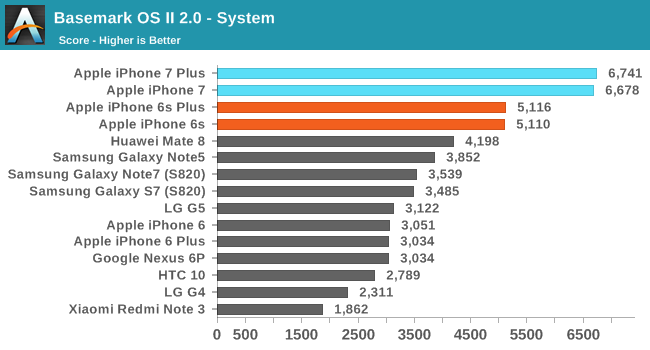
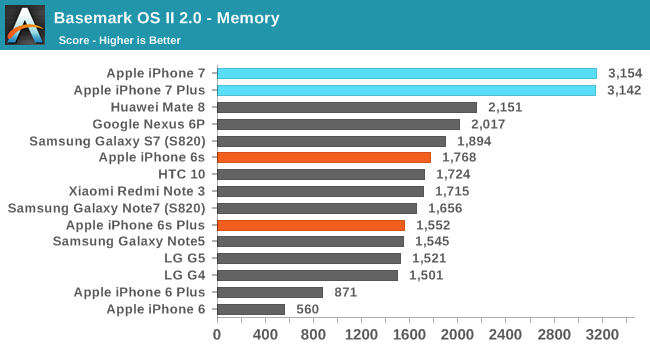
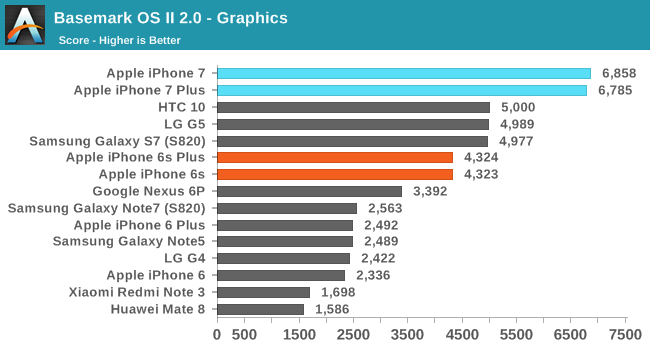
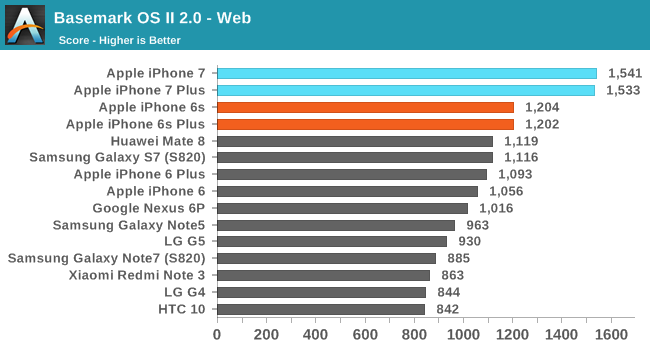

I've brought back BaseMark OS II for this review, although unfortunately the reason has less to do with wanting it back in the benchmark suite and more to do with there being very few cross-platform general system benchmarks nowadays. You can focus on the GPU, or the CPU, but the major system performance benchmark in mobile is PCMark and it remains exclusive to Android. BaseMark OS II is a pretty large optimization target now, and while it does test many aspects of the system it doesn't do so by directly simulating the tasks that a user would perform. Despite that, it helps in getting a holistic view of a device's performance by going beyond tests of a single component, so it's not without its uses.
The iPhone 6s and 6s Plus have remained the fastest overall devices in this test, so it's really just a matter of seeing how much Apple has improved. The latest generation of Android devices outpaced the GPU performance Apple's A9 SoC some time ago, so that's one area where Apple could stand to improve against the competition. As it turns out, they have. The iPhone 7 and 7 Plus show significant gains over their predecessors across the board. Performance in the system sub-test is up by 25-30%, and the graphics score is right in line with Apple's claimed 50% increase in performance. Web shows similar gains to system, which makes sense given that both are relatively CPU-bound.
The memory/storage test also shows a large improvement, which is interesting at first glance given that Apple didn't highlight any improvements in this area. However, this is just the result of the tested units being the 256GB model. On my retail iPhone 7 which is 128GB the memory score is essentially the same as the iPhone 6s which was also tested in a 128GB configuration. This comes down to the fact that these devices use a hybrid SLC/TLC storage solution, where the SLC storage can be used for writes and data can be moved later as needed. It's likely that on the 128GB iPhones the BaseMark OS II memory test is exceeding the size of the SLC cache, leading to lower scores based on the performance of the TLC NAND. On the 256GB iPhone the SLC cache is large enough to fit the entire data set used in the test, leading to a much higher score.
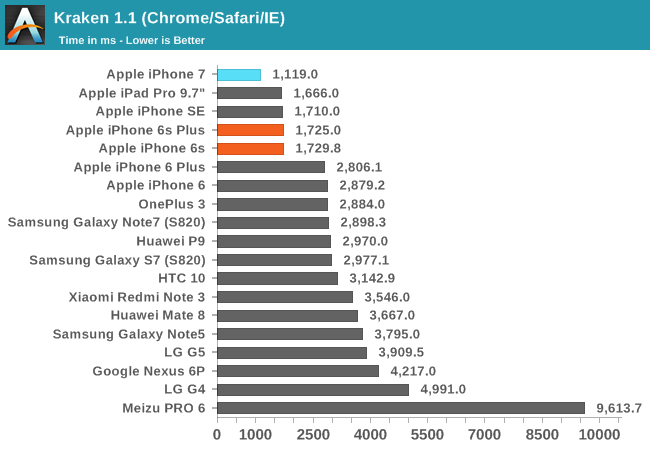
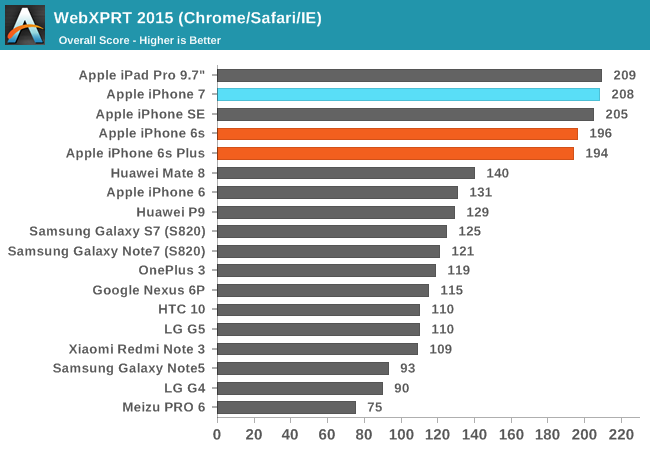
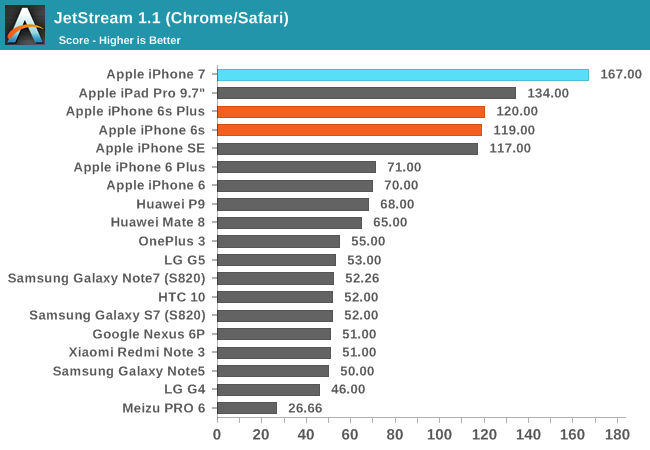
Web performance is an interesting case. While Apple's continued increases in single core CPU performance have benefited web performance with each generation, the truth is that improvements Mobile Safari's Nitro JavaScript engine have contributed a great deal as well. When looking at the charts you can see that there's a significant gap between the iPhone 7 and the next device, with the exception of WebXPRT where it's tied. What's more important than this gap is what the second device actually is. It's always another Apple device, and the same is true for the third device, and the fourth device, and so on. In Kraken and Jetstream the top seven devices on the chart are Apple's mobile devices, and the charts only have seven Apple devices in total. The Huawei Mate 8 is able to move ahead of the iPhone 6 in WebXPRT, but the gap between it and the iPhone 6s is still enormous. While Apple has continued to advance their web performance, it hasn't been with the immediate goal of beating the Android competition, as the best Android devices are still just trading blows with the iPhone 6.
WebXPRT is a small exception. As far as mobile benchmarks go, it's quite long and has short bursty workloads with pauses between each to simulate how a user would pause between different actions while using the browser. I suspect that in this case we're seeing the effects of A10 switching between its low power and high performance cores, causing parts of the test to be run on the little cores, which are not as performant. In fact, In the case of very quick actions that take only tenths or hundreths of a second to complete, it may not be possible to switch to the high performance cores before the operation has ended, causing the score to reflect the performance of the low power cores instead.
While it might seem reasonable to attribute the superior web performance of iOS devices to Apple's focus on improving single threaded CPU performance, the fact that Android devices with Cortex A72 CPUs are only matching Apple's A8 SoC shows that the gap is not only due to the CPU power available. Chrome's generally poor performance on Android is a significant limiting factor, and you can see in the chart how the improvement in Android device CPU performance over time has not translated into anything close to the sorts of gains that Apple has seen in the same period. While there are customized versions of Chromium like Snapdragon Browser that provide optimizations for a class of SoCs, it doesn't look like the gap between Android devices running Chrome and iOS devices running Mobile Safari is going to close any time soon, and if anything, it's only widening with each year.


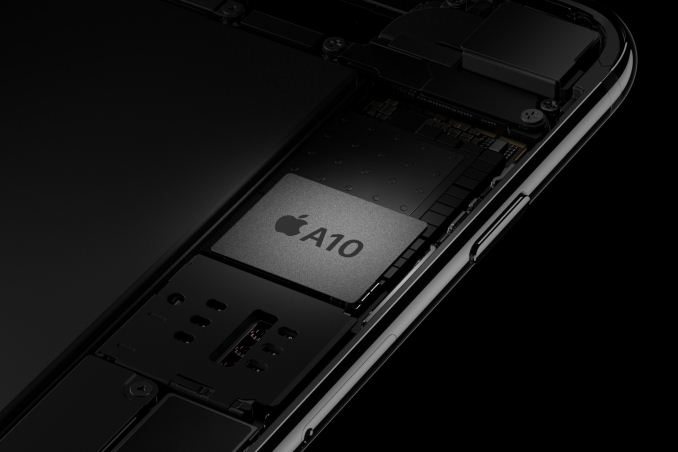








377 Comments
View All Comments
UtilityMax - Wednesday, October 12, 2016 - link
They don't the same OS, but they often run the same applications, so the comparisons are valid. For example, there exist the same web browser benchmarks that run on both OSes.Constructor - Monday, October 17, 2016 - link
On top of the faster CPUs, iOS is also optimized for more efficient resource use plus several special 64 bit optimiziations.Especially memory garbage collection on Android was a bad design mistake which keeps devices stuttering at random intervals.
ACM.1899 - Wednesday, October 12, 2016 - link
"the headphone jack because that’s what users say they want."i have bunch of nice earphones at home and i don't need (want) to buy BT headphones.
they removed the 3.5mm jack and what did they add instead? at least a built in dac (like HTC 10, v10 or v20) would have been nice.
i've heard the sound through the dongle isn't as good as iPhone 6s.
or bluetooth headphones (in general) are not as good as analog headphones (with the same price).
every time Apple does something stupid we say it's because of this or that or for that you can do this or it's the future....but WHY?
for now the only (main) reason is marketing.(Apple & Beats)
as long as a good BT headphone is not the same price as a good analog headphone , i don't want them.
until then the 3.5mm jack should have not been removed.
at least i don't need that bs taptic engine...
ACM.1899 - Wednesday, October 12, 2016 - link
or if Audio (through a smartphone) is that important to me , i can buy an android phone.btw i guess they won't remove it from the mid-range iPhone (SE).
serendip - Wednesday, October 12, 2016 - link
That Redmi Note 3 will be staying at the top of the WiFi web browsing chart for a while longer. How the heck did AT get 12 hours? I've got the same phone and the longest I've seen is 10 hours on WiFi with LTE on but not enabled for data.zodiacfml - Wednesday, October 12, 2016 - link
I love your conclusion piece. I still hate Apple but they are commendable for the constant SoC improvement and the large die size of it. I'd get over the missing headphone jack if the quality of the adapter is good. They did an awesome job on the display too, extracting the best possible performance from the display. I'd get goosebumps if they would the same attention to detail using AMOLED displays for the next generation.I never warmed to the Google Pixel devices as they are too expensive with the unimpressive Snapdragon 821 or 820. I'd just get an S7 Edge for the hardware. The software part is the only missing piece as I'd rather have stock Android with yearly, latest updates from Google.
UtilityMax - Wednesday, October 12, 2016 - link
SoC improvement is fine, but how much SoC improvement do people really need? It's not like smartphones are running PC games or are using for engineering design work. A three year old Nexus 5 with its Snapdragon SoC is still perfectly adequate as a daily smartphone when SoC is concerned. Now, the SD820 offers about twice the performance.blackcrayon - Wednesday, October 12, 2016 - link
How much? An infinite amount. It has to keep increasing in order for smartphone operating systems to get increasingly better. One example is using CPU power to increase photo quality. But no one wants to wait 10 seconds between shots...UtilityMax - Wednesday, October 12, 2016 - link
Your argument is useless because not even a one year old Nexus 5X with a much criticized Snapdragon 808 SoC does not need to take so much time to take a picture. Any modern smartphone has a pretty adequately fast camera. If you find a smartphone with a slow camera that's not an excuse to buy an overpriced iphone with no expandable storage, no "approved" way to upload your media into it without using the iTunes junk, and no 3.5mm headphone jack.blackcrayon - Wednesday, October 12, 2016 - link
Your counterargument is u... nevermind.You need to research what happens when you take a photo on a modern smartphone. There is a lot of processing done in software, which of course utilizes the hardware, to achieve better photos than would be possible without it. I'm not sure what you think your comparison means though. An iPhone "1" could take pictures too. It doesn't mean it could do the kind of instantaneous post processing something like an A10 can do. In this particular case it's Apple's ISP doing much (most?) of the work, but the analogy still stands. In order to add enhancements to the device that can work without drawbacks, they have to be fast. The more speed you have to spare, the more cycles you can use on things like instantaneous image processing, compression/decompression, "AI" that works locally on the phone, etc.
Anyway, the Nexus 5X running Chrome alone should tell you SoCs aren't fast enough, especially with a poorly optimized app.